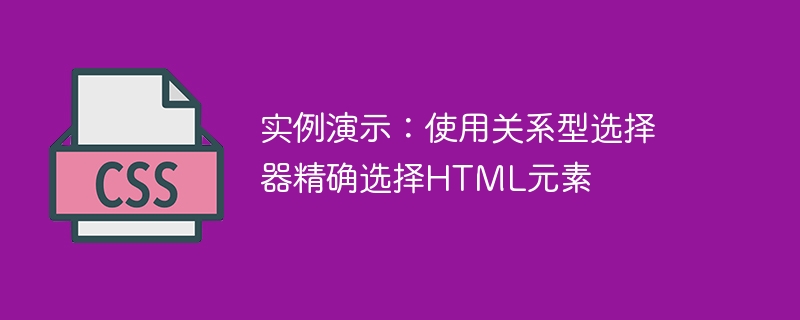

Example demonstration: Using relational selectors to accurately select HTML elements requires specific code examples
In HTML development, we often need to use selectors to accurately specify the requirements. Action or style modification of the element. CSS provides numerous selectors for matching different elements, among which relational selectors can further select elements more precisely based on the relationship between elements. Below I will use several specific code examples to demonstrate how to use relational selectors to accurately select HTML elements.
The child element selector is used to select the direct child elements of the specified element. It uses the greater than sign (>) to indicate the relationship between elements. For example, the following code will select all elements with class "parent" that are direct children of elements with class "child":
.parent > .child {
color: red;
}The adjacent sibling selector is used to select the sibling elements immediately following the specified element. It uses the plus sign ( ) to indicate the relationship between elements. For example, the following code will select all elements with class "first" followed by elements with class "second":
.first + .second {
color: blue;
}General sibling selectors are used to select all sibling elements behind the specified element. It uses the tilde (~) to indicate the relationship between elements. For example, the following code will select all elements with class "second" that follow all elements with class "first":
.first ~ .second {
color: green;
}The descendant selector is used to select all descendant elements within the specified element. It uses spaces to indicate relationships between elements. For example, the following code will select all elements with class "child" inside all elements with class "parent":
.parent .child {
font-size: 16px;
}The above are examples of several commonly used relational selectors. By using these selectors, we can more accurately select the HTML elements to be manipulated, thereby achieving style modification or other interactive effects. At the same time, we can also combine these selectors according to actual needs to achieve more complex selection purposes.
It should be noted that when using relational selectors, we should flexibly choose the appropriate selector according to the actual situation to avoid using overly complex selectors that may cause performance problems. In addition, in order to improve the readability and maintainability of the code, it is recommended to use semantic class names in CSS to name elements and reasonably structure the HTML document.
To sum up, the relational selector is one of the commonly used selectors in CSS, which can accurately select HTML elements through the relationship between elements. Demonstrates the use of child element selectors, adjacent sibling selectors, general sibling selectors and descendant selectors through examples. By flexibly using these selectors, we can easily select specified HTML elements to achieve more efficient style operations or other interactive effects. In actual development, we should choose appropriate selectors based on actual needs and follow a standardized and maintainable programming style to improve code quality.
The above is the detailed content of Relationship-based selectors: an example of precise selection of HTML elements. For more information, please follow other related articles on the PHP Chinese website!
 direct3d function is not available
direct3d function is not available
 My computer can't open it by double-clicking it.
My computer can't open it by double-clicking it.
 Introduction to software development tools
Introduction to software development tools
 Usage of Type keyword in Go
Usage of Type keyword in Go
 Introduction to the main work content of the backend
Introduction to the main work content of the backend
 Tutorial on buying and selling Bitcoin on Huobi.com
Tutorial on buying and selling Bitcoin on Huobi.com
 How to use countif function
How to use countif function
 What currency is PROM?
What currency is PROM?




